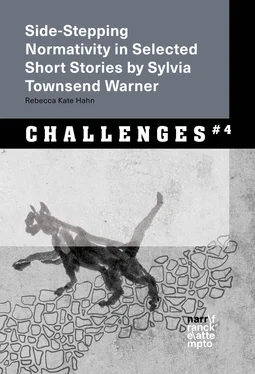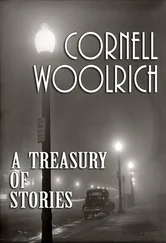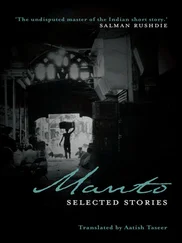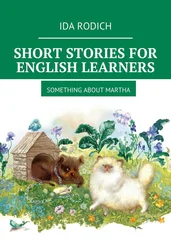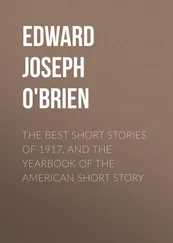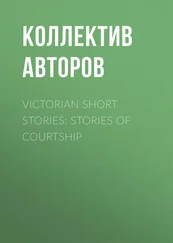
Rebecca Hahn
Side-Stepping Normativity in Selected Short Stories by Sylvia Townsend Warner
Narr Francke Attempto Verlag Tübingen
[bad img format]
© 2020 • Narr Francke Attempto Verlag GmbH + Co. KG
Dischingerweg 5 • D-72070 Tübingen
www.narr.de• info@narr.de
Das Werk einschließlich aller seiner Teile ist urheberrechtlich geschützt. Jede Verwertung außerhalb der engen Grenzen des Urheberrechtsgesetzes ist ohne Zustimmung des Verlages unzulässig und strafbar. Das gilt insbesondere für Vervielfältigungen, Übersetzungen, Mikroverfilmungen und die Einspeicherung und Verarbeitung in elektronischen Systemen.
E-Book-Produktion: pagina GmbH, Tübingen
Print-ISBN 978-3-8233-8389-5
ePub-ISBN 978-3-8233-0217-9
For Zoë and Juno
I owe thanks to many people who have all helped me in various ways to complete this book. I am especially grateful to my supervisor, Ingrid Hotz-Davies, who first kindled my interest in the writing of Sylvia Townsend Warner. Conversations with Ingrid Hotz-Davies, her enthusiasm and enlightening criticism helped me shape and reshape my ideas. I would further like to thank Christoph Reinfandt, my secondary supervisor, for his guidance and advice throughout the different stages of my thesis. Peter Swaab has likewise been very generous with his advice since I first contacted him in 2011. My work has benefited greatly from his constructive comments and his extensive knowledge of Sylvia Townsend Warner and her writing.
I am grateful for funding received from the German Academic Exchange Service to study at University College London, the State of Baden-Württemberg Graduate Support Act, and the FAZIT Foundation. I am further grateful to the German Academic Exchange Service for funding a trip to the New York Public Library to conduct research in the Sylvia Townsend Warner archives, the Equal Opportunity Commission of the University of Tübingen for different travel grants and the partial funding of the publication of this book, and also the Institutional Strategy of Tübingen University for sponsoring an interdisciplinary winter school on literary figurations of failure that allowed me to discuss my ideas on non-normativity and desire with an informed audience. Sections of Chapter 7 have been published in The Journal of Sylvia Townsend Warner Society (2010). Permissions to reprint are gratefully acknowledged.
Many thanks are due to my wonderful colleagues, friends, and sounding boards: Sandra Fluhrer, Eliza Cubitt, Xiang Zairong, Katharina Luther, Hanne Roth, Nathalie Walker, Raphael Zähringer, Luke Davies, Sara Vakili, Anna Berger, the members of the PhD colloquium at Tübingen University, Shetties, Nora Güthlein, and, in particular, Susanne Jung, who carefully read and commented on every chapter. My heartfelt thanks go to Gero Bauer and Jutta Kling, who provided inspiration and offered much-valued support throughout the writing process and beyond. Thanks is also due to Charlie Ohr for sketching the cat on the book cover and the team at the Centre for Gender and Diversity Research, as well as Anya Heise-von der Lippe, for stimulating discussions on feminist issues and diversity.
My grateful thanks go to Jennifer Hahn and Timothy Hahn for their humour and understanding over the past years. I am deeply indebted to my mother, Siân Williams-Hahn, who generously read the entire thesis and provided invaluable editorial suggestions. Her encouragement and extensive support made this book possible. Thank you.
As ever, a special thank you to Florian, Zoë and Juno, who make every day a brilliant adventure.
Any errors that remain are entirely my responsibility.
1. Undoing Categories: The British Author Sylvia Townsend Warner
| DT: |
This is The New Yorker fiction podcast, from The New Yorker magazine. I’m Deborah Treisman, fiction editor at The New Yorker . Each month we invite a writer to choose a story from the magazine’s archives to read and discuss. This month we’re going to hear “The Children’s Grandmother” by Sylvia Townsend Warner. […] The story was chosen by the Colm Tóibín […]. Hi, Colm. |
| CT: |
Hi, Deborah. |
| DT: |
So, The New Yorker published about 150 of Sylvia Townsend Warner’s stories over forty years, from the 1930s to the ‘70s. Where did you first start reading her? Can you tell us a little bit about her? |
| CT: |
I don’t really know anything about her at all. […] I know exactly where I bought the book [that contains “The Children’s Grandmother”]. It was a second-hand book in South King Street in Dublin. […] It was a hardback, big book, called Best Stories of the New Yorker . […] it had a story by John Updike, and I think towards the end it had this story that I didn’t think you could write [“The Children’s Grandmother”]. In other words, it really jumped at me. The fact that you could have, you know, this completely gothic story, this story that was so almost – strange, so strange that you would think, ‘Well, it’s not part of any universal experience. Not part of any common experience.’ And yet every detail, every tone in it, seemed to me fresh, and new, and incredibly interesting. (Treisman, my emphasis) |
In the interview transcribed above, Colm Tóibín talks about his reasons for choosing the short story “The Children’s Grandmother” (1950) by Sylvia Townsend Warner (1893–1977) for The New Yorker fiction podcast. Tóibín felt reading “The Children’s Grandmother” opened up a whole new reading experience for him. His immediate thought was that Warner had succeeded in writing about an almost impossible topic. His reply to Treisman’s question – whether he could tell his listeners more about the writer whose story he had chosen to discuss – contains some telling remarks. He points out that he is neither familiar with Warner’s writing nor her biography, and that he was drawn in by the ‘strangeness’ of the story.
“The Children’s Grandmother” is an intriguing, atmospheric short story that, amongst others, artfully negotiates preconceived notions of motherhood and grandmotherhood. It portrays the narrator’s elderly mother-in-law whose life is overshadowed, as the reader comes to believe, by the tragic loss of her seven children, one of whom was the narrator’s husband.
Early on in the story, the reader notices that the grandmother has a very matter-of-fact attitude towards bereavement, and, seemingly, talks about her dead children without a hint of emotion:
My husband, the last of my mother-in-law’s children, and born a long interval after the others, was the only one who lived to grow up, his childhood intimidated by the presence, which was also the absence, of Madeleine, Guy, Everard, Lucas, Alice, and Noel. He grew up an only child, in the middle of this shadowy band of brothers and sisters whom his father and the servants assured him were angels in Heaven, whom his mother told him were dead. (Warner, “The Children’s Grandmother” 35)
Here the reader learns that, instead of offering her last remaining son solace in view of the death of his siblings, his mother curtly informs him that his siblings are dead and gone. This passage artfully echoes Wordsworth’s poem “We are Seven” (1798), which revolves around the speaker of the poem’s conversation with the “little cottage girl” (5). Asking her, “‘Sisters and brothers, little Maid, / How many may you be?’” (13–14), she answers “‘Seven in all’” (15). Despite the fact that two of her siblings, “Jane” and “John”, have passed away, the child insists that “we are seven” and that Jane and John are just as present as her living siblings (18). Moreover, by constantly adding Jane and John to her sibling group, the girl effectively renders the speaker’s words, “But they are dead; those two are dead! / Their spirits are in heaven!”, powerless (65–66). While the girl’s utterances demonstrate that she has reconciled herself with the fact that Jane and John “in the church-yard lie” (21), the protagonist’s mother-in-law’s terse reply invites the thought that she has not yet come to terms with the death of her children and is seeking to suppress her grief.
Читать дальше
